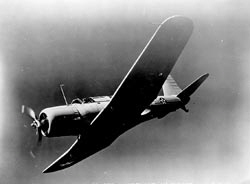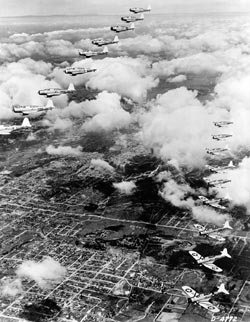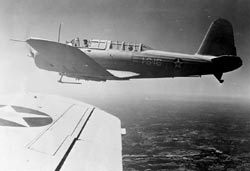|
|||||||
|
VMSB-131 was based at Quantico, Virginia during the pre-war years. After December 7, 1941 they were moved to the West Coast. Although they trained extensively in dive-bombing techniques off the coast of San Diego during early-1942, when the squadron deployed to the Pacific, rumors were already spreading that they were to become the first Grumman Avenger torpedo bomber squadron in the Marine Corps. Deliveries of Grumman TBF-2 Avengers began on September 24, 1942 when the squadron received nine Avengers. By the time the squadron landed on Henderson Field, Guadalcanal, on November 12, all the SB2U-3ís had been replaced. During June of 1943 the squadron officially dropped the scout/bombing title and became VMTB-131. Just prior to the Japanese attack on Pearl Harbor, USS Lexington had embarked with 18 SB2U-3ís of VMSB-231 (of the 24 aircraft assigned) for transportation to Midway Island. When the ship received word of the Japanese attack, she turned back and flew the SB2U-3ís back to their base at Ewa. On arrival at MCAS Ewa, the squadron found that its remaining six SB2U-3ís had been destroyed on the ground during the Japanese attack. On December 17, 1941, the remaining air-worthy SB2U-3ís (17 aircraft) of VMSB deployed from Ewa for the long over-water flight from Hawaii to Midway Island. Led by a PBY Catalina, the unit set a new distance record for a flight of single-engine aircraft. The squadron completed the 1,137-mile journey in 9 hours and 45 minutes, proving that the SB2U-3 had extremely ďlong legs.Ē
On the night of June 3, 1942, the Battle of Midway opened with an attack by Army Air Force B-17ís and Navy PBYís against the Japanese troop ships of the Midway Occupation Force. The next morning the Japanese launched 128 Zero fighters, Val dive-bombers and Kate level bombers against Midway. At 0545 these aircraft were spotted by a patrolling PBY that alerted Midway of the incoming Japanese strike. The first wave off in response to the warning were the six TBF1 Avengers of VT-8 followed by four Army B-26 Marauders. The second wave off were the sixteen SBD-2ís of VMSB-241 led by Maj Lofton R. Henderson. They were followed by a flight of seventeen B-17 Flying Fortress bombers, and last off were the twelve SB2U-3ís. The Vindicators had simple orders - seek out and attack the approaching Japanese fleet. Shortly after takeoff, one of the SB2U-3ís returned to Midway with mechanical problems while the eleven remaining SB2U-3ís went on toward the Japanese. Each Vindicator was armed with a single 500-pound bomb on the centerline bomb rack. The SBD element reached the Japanese ahead of the slower SB2U-3ís and immediately attacked in a shallow glide bombing attack from 4,000 feet. Their target was the Japanese carrier Hiryu; however, the carrierís Combat Air Patrol was ready. Maj Henderson was the first to be shot down by the Zero CAP. Five additional SBDís followed him in only minutes. Capt Richard E. Fleming (who was killed flying an SB2U-3 the next day) took over the lead and continued the attack on the Hiryu. Fleming and his gunner, Cpl Eugene T. Card, managed to make their dive and drop their bomb, although their SBD-2 was shot up and Cpl Card was wounded in the attack. None of the SBDís scored a hit ó eight were shot down and the rest were damaged. The SBD divisions of VMSB-241 headed back to Midway as the SB2U-3ís found the Japanese fleet. They were on the opposite side of the fleet from the carriers. Maj Benjamin W. Norris, flying the lead Vindicator, began a shallow dive from approximately 13,500 feet, followed by 2Lt George T. Lumpkin and 2Lt Kenneth O. Campion. Their target was the Japanese battleship Haruna and Norris managed to score a near miss that caused some damage to the Japanese battleship.
Later that day, VMSB-241 was called upon to find and attack a Japanese carrier believed to be burning some 200 miles northwest of Midway. Six SBDk-2ís and six SB2U-3ís took off at 1900 to search for the carrier. Maj Norris led the SB2Uís and Capt Marshall A. ďZackĒ Tyler led the SBD-2ís. The weather was bad in the search area and the target could not be located. On the return to Midway, Maj Norrisí Vindicator was seen to go into a steep right turn and disappeared. The rest of VMSB-241 made it to Midway safely. At 0705 on June 5, the remaining SBD-2ís and SB2U-3ís took off to find and attack the heavy cruisers, Mikuma and Mogami, part of RADM Takeo Kuritaís Cruiser Division 7. Capt Tylerís SBD group made a standard dive-bombing attack but failed to hit their target, the Mogami. The SB2U-3 flight went in as dive bombers, attacking the Mikuma. Captain Richard E. Fleming, whose SBD had been damaged in the action the previous day volunteered to fly an SB2U-3 with Capt Tylerís group. Flemingís plane was apparently hit at the start of the attack and burst into flames. Neither Fleming nor his rear-seat gunner, Pfc George A. Toms, escaped the burning Vindicator. For his actions during the Battle of Midway, Capt Fleming received the Congressional Medal of Honor, the first awarded to a Marine pilot in the Second World War. Later that day, Navy SBD dive-bombers from the USS Enterprise sank the Mikuma and set the Mogami afire. VMSB-241 was re-organized after the Midway battle and stayed on the island until March of 1943 when it rotated back to Hawaii. The squadron retained at least three of its SB2U-3ís until September of 1943. More SB2U: Atlantic Operations
|

 On July 1, 1941, Marine Scouting Squadron One (VMS-1) became Marine Scouting Bombing Squadron One-Thirty-One (VMSB-131) under a new identification system which identified the organizational structure of the unit. The designation identified the squadron as belonging to the First Marine Air Wing (1), Third Marine Air Group (3), and the last designated the unit as the First scout-bombing squadron with the Group.
On July 1, 1941, Marine Scouting Squadron One (VMS-1) became Marine Scouting Bombing Squadron One-Thirty-One (VMSB-131) under a new identification system which identified the organizational structure of the unit. The designation identified the squadron as belonging to the First Marine Air Wing (1), Third Marine Air Group (3), and the last designated the unit as the First scout-bombing squadron with the Group.
 The Vindicators joined the F2Aís of VMF-221 forming Marine Air Group 22. Shortly after their arrival at Midway, half of the squadronís personnel returned to MCAS Ewa where they became the cadre of a reorganized VMSB-231, and began transition training in the SBD-2 Dauntless. The unit at Midway, on March 1942, was re-designated as VNSB-241 and took the squadron name, Sons of Satan. On May 26, the squadron was reinforced by the arrival of nineteen SBD-2 Dauntless dive-bombers that had been ferried to the island by the aircraft ferry USS Kitty Hawk. From that point on, the pilots flew training missions over the Pacific, near the island, in preparation for action against the Japanese.
The Vindicators joined the F2Aís of VMF-221 forming Marine Air Group 22. Shortly after their arrival at Midway, half of the squadronís personnel returned to MCAS Ewa where they became the cadre of a reorganized VMSB-231, and began transition training in the SBD-2 Dauntless. The unit at Midway, on March 1942, was re-designated as VNSB-241 and took the squadron name, Sons of Satan. On May 26, the squadron was reinforced by the arrival of nineteen SBD-2 Dauntless dive-bombers that had been ferried to the island by the aircraft ferry USS Kitty Hawk. From that point on, the pilots flew training missions over the Pacific, near the island, in preparation for action against the Japanese.
 Other SB-2U-3ís under Maj Norris were intercepted by the Japanese carrier Air Patrol Zeros. Sgt Frank E. Zelnis, gunner aboard SB2U-3 #11 flown by 2Lt Sumner H. Whitten, claimed one of the A6M2 attackers was destroyed. Other members of the squadron made runs on the Japanese ships but did not score any hits. Two SB2U-3ís, one flown by 2Lt Kenneth O. Campion and Pvt Anthony J. Madey, and one flown by 2Lt James H. Marmande and Pfc Edby M. Colvin (A/C #6), failed to return and the cause of each disappearance is unknown. Another SB2U-3, flown by 2Lt Allan H. Ringblom ran out of gas on the return to Midway and ditched. Ringblom and his gunner, Pvt Eugene L. Webb, were rescued by PT-26, while PT-20 picked up Lt Cummings who had ditched his Vindicator just a few miles short of Midway.
Other SB-2U-3ís under Maj Norris were intercepted by the Japanese carrier Air Patrol Zeros. Sgt Frank E. Zelnis, gunner aboard SB2U-3 #11 flown by 2Lt Sumner H. Whitten, claimed one of the A6M2 attackers was destroyed. Other members of the squadron made runs on the Japanese ships but did not score any hits. Two SB2U-3ís, one flown by 2Lt Kenneth O. Campion and Pvt Anthony J. Madey, and one flown by 2Lt James H. Marmande and Pfc Edby M. Colvin (A/C #6), failed to return and the cause of each disappearance is unknown. Another SB2U-3, flown by 2Lt Allan H. Ringblom ran out of gas on the return to Midway and ditched. Ringblom and his gunner, Pvt Eugene L. Webb, were rescued by PT-26, while PT-20 picked up Lt Cummings who had ditched his Vindicator just a few miles short of Midway.